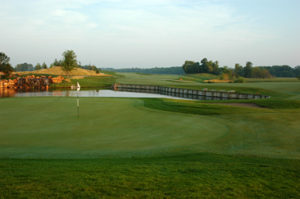Garrett Gill, ASGCA, along with Paul Miller and Duininck Brothers Golf, Inc., constructed The Meadows at Mystic Lake in Prior Lake, Minnesota. The golf course project addressed several environmental issues and reflected the cultural values of the local tribal community in preservation, protection, and enhancement of land.
The project’s purpose was to provide a destination championship 18-hole golf course to complement Mystic Lake Casino and to provide golf recreation opportunities for the Shakopee Mdewakanton Sioux Community (SMSC) tribal members and their families. The site itself is comprised of approximately 140 acres of the former Lone Pine Golf Course and approximately 45 acres of adjoining tribal land adjacent to the Mystic Lake Casino in Prior Lake, the latter being comprised of a parking lot and a spoil area for the ongoing casino/hotel expansion project.
In the development of the project, many environmental concerns were tackled: preservation and protection of existing wetland habitats; improvement/treatment of the quality of storm water runoff from adjacent impermeable surface areas; and reduction of ground water usage from aquifers for irrigation purposes.

Hole 18, The Meadows at Mystic Lake, Prior Lake, Minnesota
After the site underwent an initial survey and mapping for topography, vegetation, wetlands, and other physical and natural constraints, the Shakopee Mdewakanton Sioux Community Business Council and their Land and Resources Department formulated some environmental objectives for the project. Some of these goals included: protect perimeter wetlands; create open water areas to increase water-based flora and fauna; minimize the need to use groundwater as a source for irrigation by developing a storm water capture system and by utilizing wastewater reclamation; preserve and protect existing vegetation for replanting; establish a culturally-based indigenous landscape planting theme throughout the course; and institute culturally-based symbolism through sculpture within the course. When choosing a routing for the holes, a key to the selection process was the evaluation of each concept’s ability to meet the stated development objectives.
In constructing the course, the builder created a system of large interconnected ponds in the lower elevations of the course as storm water detention and retention features for the golf course. In addition, a 2,600-foot long re-circulating open water creek and waterfall system was incorporated into the golf course to oxygenate and aerate the captured storm water. An extensive amount of sod was used in rough areas to reduce erosion potential on steeper slopes and to expedite stabilization.
The construction team used low fertility and low water-use bent-grasses on the green, tee, and fairway areas to conserve water resources, and incorporated low-maintenance, no-mow prairie-type and shrub/tree planting areas into the course to promote a culturally and historically accurate indigenous landscape palette. To further promote the sensitivity, importance, and protection of the land by the Shakopee Mdewakanton Sioux Community, culturally significant animal sculptures were placed in visible out-of-play landscape areas on the course.
Throughout the construction process, the golf course builder paid close attention to the sensitive areas and features of the site. The par 72, 7100-yard golf course opened in 2006 and remains a delightful experience for golfers.
To read more Environmental Case Studies, please visit here.
